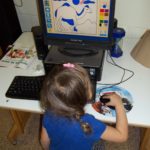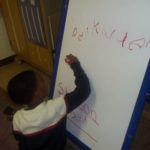ACHR’s Child Development Program uses a team approach to education. ACHR believes that parents and guardians are their children’s most important teachers and role models. Therefore, our staff supports, encourages, and works to empower parents and guardians in many ways to be the best possible teachers and role models for their children. We also believe that young children learn best when they are allowed and encouraged to be children. That includes allowing them to be curious, focus on what they are interested in at any given time, learn by doing, and make (and clean up) messes.
Teaching Strategies

Because of its many positive qualities, ACHR staff and parents chose to use the HighScope Curriculum ® in Head Start classrooms starting in 1978 and with Early Head Start children since we began that program in 1998. After careful review, as of August 2023, ACHR began using the Creative Curriculum. ACHR’s Head Start/Early Head Start (HS/EHS) delivers educational programming that explicitly intends to close the achievement gap before children leave our program for kindergarten. We deeply believe that for infants, toddlers, and preschool-aged children, high-quality early childhood education that is emotionally supportive and developmentally appropriate improves the physical and cognitive outcomes of children. It can also result in enhanced school readiness. In our experience, all children can learn, grow, and succeed when the professional development of teachers is combined with educational approaches rooted in a scientifically valid, developmentally appropriate curriculum driven by widely accepted research. Therefore, our approach, like Creative Curriculum, is aligned to meet the needs of the “whole child.”

The Creative Curriculum:
At its core, the Creative Curriculum is grounded in sound developmental theories and empirical research. Drawing from the works of renowned theorists such as Jean Piaget, Erik Erikson, and Lev Vygotsky, this curriculum recognizes the significance of active, constructivist learning. Research shows that children learn best when they are actively involved in constructing knowledge through self-directed activities. The Creative Curriculum emphasizes hands-on learning, allowing children to explore, question, and understand their environment, ensuring that their cognitive, linguistic, social-emotional, and physical development domains are catered to holistically.
Culturally and Developmentally Appropriate: The Creative Curriculum is flexible in its approach and allows the adaptation and individualization necessary for HS & EHS. Recognizing the diverse tapestry of our society, it ensures that learning experiences are culturally relevant and responsive. By fostering a deep appreciation for diversity, the curriculum encourages children to understand and respect differences from a young age, building the foundation for global citizenship. Furthermore, understanding that each child’s developmental path is unique, the curriculum provides individualized opportunities for learning, ensuring that every child—regardless of their starting point—can thrive.
One of the standout features of the Creative Curriculum is the support for dual language learners. Recognizing the cognitive benefits of bilingualism and the challenges dual language learners face, the curriculum incorporates strategies to bolster both the child’s primary language and English. This dual focus not only aids in linguistic development but also preserves the child’s cultural identity, ensuring they remain connected to their roots while navigating a new linguistic landscape.
Efficacy with Vulnerable Children: When working with vulnerable children, the need for a sensitive and adaptable curriculum becomes even more pronounced. Several studies have highlighted the Creative Curriculum’s effectiveness in catering to this group. It promotes a safe, nurturing environment, essential for children who may face trauma or instability outside the classroom. A keen focus on social-emotional development helps build resilience, self-esteem, and coping skills—attributes crucial for children in challenging circumstances. Furthermore, the curriculum’s emphasis on family engagement ensures that caregivers, often the child’s first teachers, are actively involved, bridging the gap between home and school and providing consistent support for the child.
The curricula integrate instruction across developmental domains and early learning disciplines, including language, cognitive, physical, social, and emotional learning. It also embeds research-based, age-appropriate content and best practices through innovative instructional strategies that produce measurable gains in children’s achievement and outcomes. This innovation includes the Conscious Discipline strategy that supports social and emotional intelligence (SEL) and cognitive performance. Conscious Discipline is also comprehensive and evidence-based and utilizes a trauma-informed approach that provides an array of behavioral management strategies and classroom structures that teachers can use to turn everyday situations into learning opportunities. Creative Curriculum’s exclusive partnership with Conscious Discipline is advantageous to the curriculum as the strategy has impacted an estimated 15 million children. Through implementing the Creative Curriculum, teachers will routinely utilize Conscious Discipline processes such as the daily greeting ritual, safe spaces, and breathing techniques. In our proposed classrooms, these intervention steps will help children regulate their emotions, mediate conflict resolution, develop social skills, and improve appropriate peer-to-peer interactions. Additionally, teachers in other Head Start have experienced reduced behavioral disruptions during various center times as Conscious Discipline is increasingly introduced and implemented. For example, our teachers will use Conscious Discipline skills to address tantrums, which are a form of non-verbal communication. Head Start children sometimes use these tantrums as a way of developmental communication to indicate when they are feeling “overwhelmed” or even learned behavior in instances where previous negative behavior may have been successful. Conscious Discipline skills are initially used to create a calming environment, followed by a display of empathy by taking deep breaths with the child using soft, calming words. Conscious Discipline aids us in building emotional literacy throughout daily routines, teacher-child interactions, and conversations. It also aids our teachers in providing children with necessary tools, such as positive language for self-regulation and communicating their needs. For instance, a day in our classrooms may begin with the morning circle and the “Wishing Well” ritual, a Conscious Discipline tool that offers children a way to calm and support each other, supported by our teachers. Conscious Discipline also helps our children self-regulate through another concept centered on belly breathing, called S.T.A.R. (“Smile, Take a deep breath And Relax”), which focuses on exhaling techniques. Our teachers have successfully used this breathing and calming tool to help our children release any anxiety that led to distracting behaviors.
Creative Curriculum’s creators also bring a wealth of expertise in the field of early childhood classroom experience, brain development, literacy, second language learning, and the integration of science, technology, engineering, and math (STEM) practices. STEM’s inclusion and implementation in our program is significant because preschool and early elementary years are often centered around literacy. As a rule of thumb, much of the development of math skills during this period is rote memorization. Creative Curriculum also aligns with the Head Start Early Learning Outcomes Framework. The Head Start Early Learning Outcomes Framework is designed to show the continuum of learning for infants, toddlers, and preschoolers. Our teachers incorporate these elements at the appropriate developmental stage within each child’s individualized lesson plan. While reading and basic math skills are fundamental and imperative for school readiness, they are also a vital part of STEM development at an early age, as STEM aims to be less about memorization and more about creating solutions to problems that help children think. Based on developmental and cognitive neuroscience research, Creative Curriculum supplements STEM through an instructional model that identifies strategies supporting and enhancing skill sets to ensure long-term memory, awareness, and information processing.
